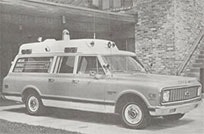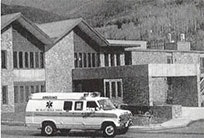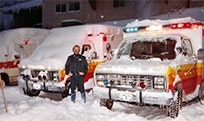Eagle County Ambulance District (ECAD) History
When Vail’s operation as a ski resort began in 1962, the only real medical care in Eagle County was that of a doctor contracted for the winter months to provide medical care to skiers. Ambulance service was still extremely primitive. In 1967 a station wagon was purchased for use as an ambulance and it was not unusual to see Dr. Tom Steinberg or a volunteer ski patrolman driving. A new Chevy ambulance was purchased in 1973 for approximately $8,500, in part with money from a charity golf tournament. Proceeds from a New Year’s Eve Hospital Benefit in 1975 helped to purchase a larger and better equipped ambulance.

A federal grant was awarded to the Town of Vail in 1976 and with that money and money from Vail Clinic donors a new ambulance was purchased for $11,815.00. This vehicle was used to provide emergency medical care for what was then a rural area of Colorado without adequate emergency service. This Chevrolet Sentinel “high-top” ambulance replaced two converted station wagons, carried up to four patients and allowed 60 inches of vertical working room.
By this time the ambulance service was a department of the Vail Valley Medical Center. There was one full-time emergency medical technician with an office in a ski closet. Prehospital emergency care was basic life support consisting of oxygen therapy, splinting, IV fluids and transport. Vail had grown enough by 1976 to warrant changes from its mostly volunteer service to that of a paid crew of three full-time and seven part-time EMTs. With an annual budget of less than $100,000 a third modular ambulance with a Chevy 454 engine was added at a cost of $21,900 plus $1,000 worth of equipment. It was financed by hospital funds and donations since the Ambulance Service was a department of the non-profit VVMC and was not supported by a tax base.

Turn-out was fast, less than a minute to leave the hospital. However the main reason for any delay was that the public needed to memorize a seven digit number to call in an emergency. When a potential patient called the hospital and spoke with a nurse, the nurse could determine if an ambulance was necessary and would then dispatch one.
In January 1978 the Colorado Emergency Medical Services Act empowered the state’s 63 boards of County Commissioners to adopt and enforce ambulance service licensing requirements and established the Colorado Department of Health as the lead agency for assisting the commissioners in their efforts. This was the first action by lawmakers to regulate ambulance services on a statewide basis and established types of treatment EMTs could provide.

By this period in the late 1970s, the local medical community supported advanced life support training and more full-time staff, enabling the service to become one of the first 24-hour paramedic services on the Western Slope. By 1980 the ambulance crew consisted of six members: three paramedics and three EMTs. Local doctors and the opportunity to work in the hospital Emergency Room obtained formal training as well as instruction.
In the early 1980s, financial troubles arose for the hospital and a new entity for ambulance services was sought in order to preserve this essential service. A permanent solution was to establish an ambulance district in the eastern part of the county with a combination of property taxes and patient fees to fund the district.
On April 20, 1982, Eagle County voters chose to create the Eagle County Emergency Services Hospital District, also known as Eagle County Ambulance District; on June 1, 1982, the District became official. The original five board members consisted of Vail Fire Chief Dick Duran; Eagle Vail Fire Chief Jay Hosburg; Dr. Kent Petrie; pharmacist Randy Garman and Vail Mountain Rescue Group leader Tim Cochrane.
Construction began in 1983 on the Vail ambulance station which was to house three ambulances, administrative offices, crew kitchen and bedrooms. The 4,500 square foot building was constructed for approximately $450,000, and was located adjacent to Vail Valley Medical Center (now Vail Health).

Since then, the District has responded to more than 60,000 ambulance runs; treated and transported 37,000 patients; and performed more than 5,000 patient transfers from Vail to other hospitals in the state.
With the local community growing, the District again saw the need for an expansion and on April 28, 1992 ground was broken for the District’s new building in Edwards. With this building, an ambulance response station was located west of Dowd Junction and housed additional administrative space and ambulances. The 7,000 square foot building was completed in March of 1993 for an approximate cost of $845,000.
The District became a Health Service District in 1996 to continue the provision of advanced life support and have the ability to carry out additional health care objectives such as paratransport services. In 1996, in order to distinguish its first rate medical care, the District became one of three agencies in Colorado and the 50th agency to become nationally accredited by the Commission on Accreditation of Ambulance Services, and has maintained this accreditation.
2003 saw a remodel of our Edwards facility to add an additional 4,000 square feet. This included additional administrative offices, crew bedrooms and a larger classroom.
Construction began in 2008 on the third station at Traer Creek in Avon; ECAD moved in October of 2009. This 11,416 square foot building houses a third 24 hour duty crew, a 24 hour float paramedic, two administrators and three ambulances. Our response times have decreased on the average of 2-3 minutes since 2008.
Since becoming a hospital district in 1982, a high level of financial and business responsibility has been maintained. Using modern business metrics and performance indicators to track quality assurance, cost per run, number of medics per call and several other measurements, the district has successfully operated with only one tax increase and at the same time kept our average "bill per run" below the state average. From only 718 calls in 1982, the District now responds to more than 5,000 calls per year.
